Explore Mbombela - South Africa Travel, Africa
Mbombela (previously known as Nelspruit) is a lively city in Mpumalanga, South Africa, that acts as a gateway to some of the country's most breathtaking natural treasures, including the well-known Kruger National Park. Known for its lush subtropical landscape, Mbombela draws travelers with its unique blend of wildlife, culture, and history. Whether you're seeking adventure or looking to immerse yourself in local traditions, this city offers an unforgettable experience.
Population: Approximately 820,000 in 2022.
Economy: Mbombela's economy majors in tourism, agriculture, and trade. It benefits from its proximity to Kruger National Park, thriving with local markets, retail, and services that support the region’s growth
Landmarks: Famous for the Lowveld National Botanical Garden, Kruger National Park, and Sudwala Caves.
South Africa
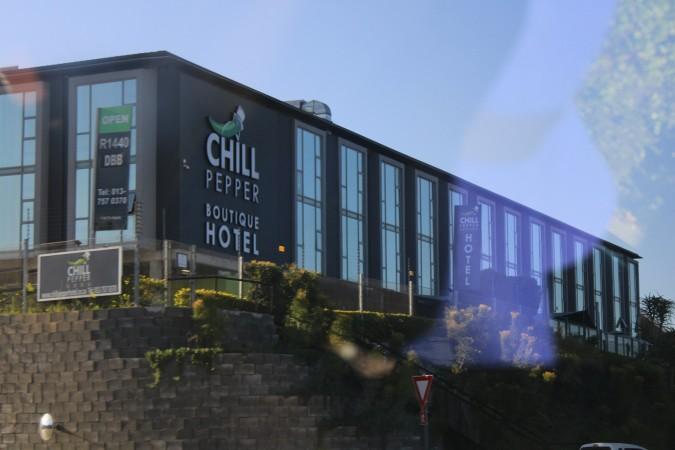
Overview of Mbombela
History & Cultural Influence
Mbombela’s history is deeply tied to the region’s indigenous peoples and European settlers. Initially a small farming town, it grew into a significant hub due to its location along the main route connecting Johannesburg to Mozambique. The city has retained its colonial roots while embracing the vibrant Swazi and Zulu cultures that influence the daily life of its people. You’ll notice this cultural fusion in local architecture, language, and traditions. The cultural heritage of Mbombela reflects a South Africa that is proud of its heritage while constantly evolving. Traditional Swazi customs, such as song and dance, often feature prominently during local festivals, offering visitors a window into the soul of this unique community.
Interaction with the Locals
Mbombela has a population of approximately 820,000 residents. The city is a melting pot of cultures, with the majority of the population being Swazi, along with Zulu, Afrikaner, and other ethnic groups. English, Swazi, and Afrikaans are widely spoken, reflecting the area's diverse heritage. The people of Mbombela are known for their warm hospitality, making it a welcoming destination for travelers.
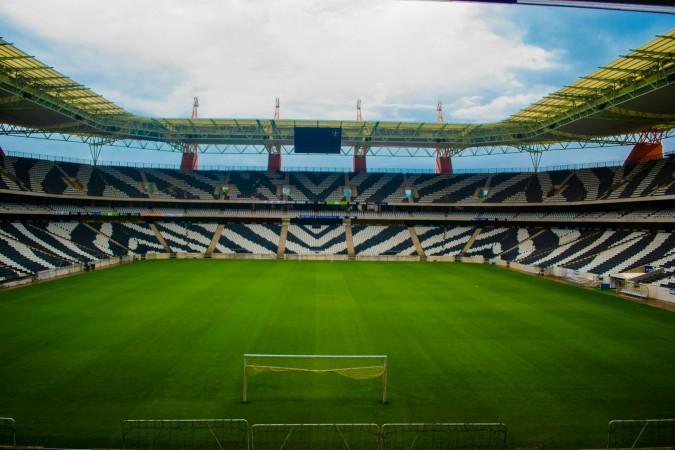
Mbombela Stadium - © Pfano Tshikumbana
Top Attractions in Mbombela
Mbombela offers a variety of attractions that cater to every type of traveler, from nature enthusiasts to history buffs.
Lowveld National Botanical Garden
One of Mbombela’s most serene locations, the Lowveld National Botanical Garden is a sanctuary for plant lovers and nature seekers. This huge garden is filled with lush tropical vegetation, indigenous trees, and breathtaking waterfalls. Walk along its scenic paths and explore various sections dedicated to rare and exotic species. It’s a great spot for relaxation, photography, and learning about South Africa’s diverse flora.
Sudwala Caves
Step back in time by visiting the Sudwala Caves, one of the world's oldest cave systems. These impressive limestone caves offer guided tours that take you deep into their chambers, where you’ll discover fascinating rock formations, ancient fossils, and underground rivers. The caves also host occasional events, such as concerts, thanks to their natural acoustics.
Mbombela Stadium
Built for the 2010 FIFA World Cup, the Mbombela Stadium is a striking piece of architecture inspired by the region’s wildlife. The stadium’s distinctive giraffe-patterned pillars make it one of the most recognizable landmarks in the city. If you’re a sports enthusiast, check the schedule for soccer or rugby matches during your visit. Even without a game, it’s worth a stop to admire the design and enjoy views of the surrounding landscapes.
Kruger National Park
A trip to Mbombela wouldn’t be complete without venturing into the nearby Kruger National Park, one of Africa’s largest and most famous game reserves. Just an hour away from the city, the park offers the chance to spot the Big Five—lion, elephant, buffalo, leopard, and rhinoceros—along with hundreds of other species. Guided safaris, self-drive tours, and luxury lodges ensure every visitor has an unforgettable wildlife experience.
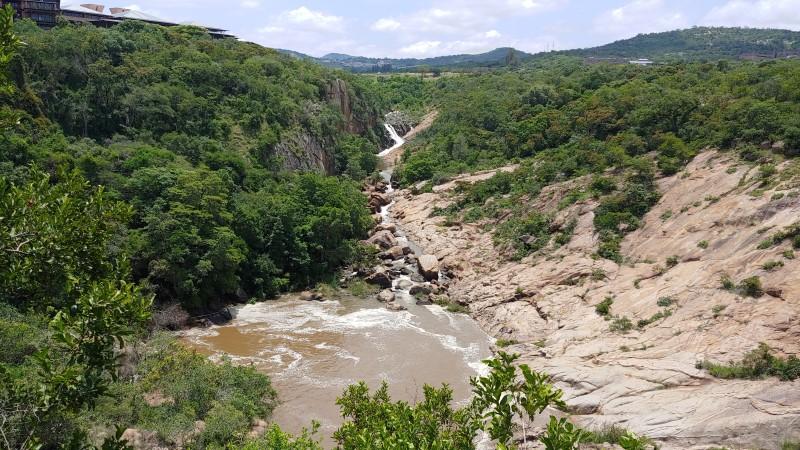
Lowveld National Botanical Garden - © Wikipedia
Must-Try Dishes in Mbombela
Mbombela’s culinary tradition is a delightful mix of traditional South African dishes and local favorites. Exploring the food here allows travelers to experience the rich heritage of South Africa’s cuisine.
- Braai: A South African favorite, braai is an essential culinary experience. Locals gather to grill meats like beef, lamb, and boerewors (a traditional sausage) over an open fire. It's often served with sides like pap (a maize-based porridge) and chakalaka (a spicy vegetable relish).
- Bobotie: Bobotie is a Cape Malay dish made of spiced minced meat, usually beef or lamb, baked with a creamy egg custard topping. It is frequently served with yellow rice, sweet raisins, and chutney to achieve a savory-sweet balance. This dish exemplifies the international influences on South African cuisine.
- Potjiekos: Potjiekos is a traditional South African stew cooked slowly in a three-legged pot over an open fire. The dish typically includes a mix of meat (such as oxtail or chicken), vegetables, and a variety of spices. It’s a hearty and comforting meal enjoyed at gatherings or family events.
- Sosaties: Sosaties are marinated meat skewers, traditionally made with lamb or chicken. They are often grilled during a braai and feature a tangy, sweet flavor from their fruit-based marinades. This dish is commonly served with side salads and rice.
- Malva Pudding: For dessert, malva pudding is a local favorite as this warm, spongy cake is made with apricot jam and served with a generous pour of custard or cream. The rich, sweet flavor makes it a perfect way to end a meal.
- Vetkoek: Vetkoek is a type of fried dough bread, often stuffed with minced meat or served with syrup and butter as a sweet treat. This versatile dish can be enjoyed as a snack, meal, or dessert and is loved for its crunchy exterior and soft inside.
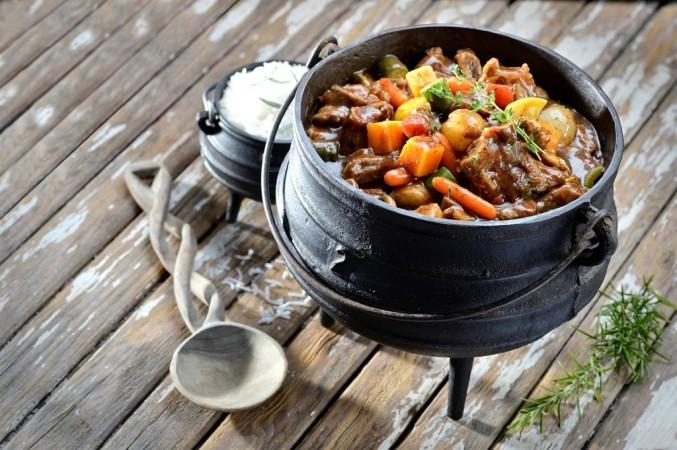
Potjiekos - © African Food Network
Festivals & Local Celebrations
Mbombela is home to a variety of lively festivals and celebrations that showcase the region's rich cultural diversity. From arts and music festivals to traditional Swazi rituals, these events offer travelers a unique glimpse into the heart of local traditions.
Innibos Arts Festival
The Innibos Arts Festival is one of the biggest cultural events in Mbombela, drawing thousands of visitors annually. It celebrates South African arts, music, and theater, featuring live performances, art exhibitions, and food stalls. Held over several days, the festival provides an immersive cultural experience for locals and tourists alike.
Swazi Cultural Festivals
Swazi culture plays a significant role in Mbombela, and traditional Swazi festivals occur throughout the year. These festivals, filled with dancing, singing, and ceremonial rituals, offer a deep dive into Swazi heritage. One such event is Umhlanga (Reed Dance), a traditional Swazi celebration where young women participate in a cultural dance as a tribute to the Swazi King.
Lowveld Air Show
For aviation enthusiasts, the Lowveld Air Show is an annual spectacle not to be missed. Held at the Mbombela Airfield, the event features thrilling aerial displays by military aircraft, helicopters, and stunt planes. It’s a family-friendly event that brings locals and tourists together for a day of excitement.
Mac Mac Cultural Festival
The Mac Mac Cultural Festival is a vibrant celebration of Mbombela's diverse cultural influences, with a focus on the town’s rich mining history. The festival features traditional food stalls, craft markets, live music, and dance performances from various local communities, offering a colorful and engaging experience for visitors.
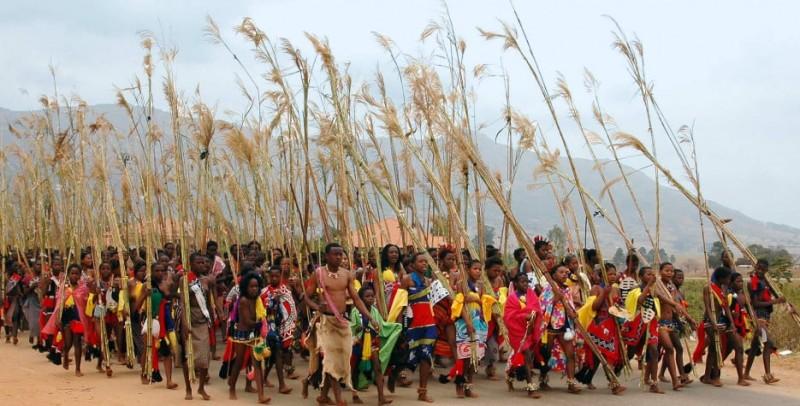
Swazi Cultural Festivals - © Office Holidays
What to Do in Mbombela
- Wildlife Safaris: With its proximity to Kruger National Park, Mbombela is the perfect base for embarking on a safari adventure. Safaris in Mbombela provide a thrilling way to experience South Africa’s iconic biodiversity up close.
- Hiking and Nature Trails: The Kaapsehoop trail, for instance, offers breathtaking views of forests, waterfalls, and even wild horses. For a more relaxed outdoor experience, take a stroll through the Lowveld National Botanical Garden to enjoy indigenous plants and peaceful surroundings.
- Elephant Sanctuary Experience: This experience allows you to interact closely with rescued elephants in a responsible and ethical manner. Guests can participate in activities such as feeding, walking with the elephants, and learning about their behavior and conservation. It’s an educational and heartwarming experience that supports wildlife protection.
- Hot Air Balloon Safari: This unique activity offers breathtaking aerial views of the Lowveld, including the lush vegetation and wildlife below. The serene flight provides a new perspective on the region’s beauty, and many ballooning operators include a celebratory glass of champagne or a light breakfast to complete the experience.
Shopping in Mbombela
- Riverside Mall: Riverside Mall, one of Mbombela's main retail malls, features a mix of local and international brands. Here, visitors can find everything from fashion to electronics, alongside a variety of restaurants and entertainment options.
- Local Craft Markets: For a more authentic shopping experience, local craft markets around Mbombela are perfect for finding handmade items, such as traditional beadwork, pottery, and textiles. These markets give travelers a chance to support local artisans and take home unique keepsakes.
- Casterbridge Lifestyle Centre: Located a short drive from Mbombela, the Casterbridge Lifestyle Centre is a boutique shopping village offering artisanal products, home décor, and specialty shops. The tranquil setting makes it a popular spot for visitors looking for a more relaxed shopping experience.
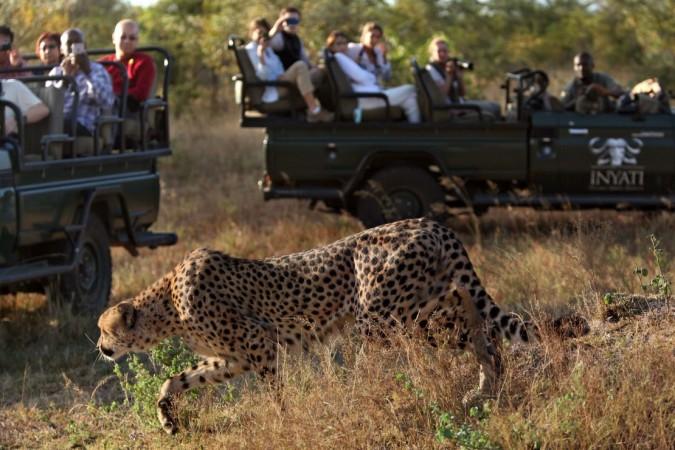
Wildlife Safaris in Kruger National Park - © CNN
Weather in Mbombela: Best Time to Visit
Spring in Mbombela
Spring brings moderate temperatures and lower humidity, with daytime highs between 20°C and 30°C (68°F and 86°F). The pleasant weather is ideal for exploring the city and its natural surroundings. This season is also great for birdwatching, as migratory birds are abundant. Spring is a popular time for travelers seeking mild weather and fewer crowds.
Summer in Mbombela
Summer in Mbombela is characterized by hot, humid conditions with temperatures often exceeding 30°C (86°F). Afternoon thunderstorms are common and provide a temporary break from the heat. This season is very popular with wildlife enthusiasts visiting Kruger National Park, since the thick vegetation allows for superb game watching. However, you should prepare for sudden rain showers and high humidity.
Autumn in Mbombela
Autumn features mild temperatures and gradually cooling conditions, with daytime highs ranging from 20°C to 30°C (68°F to 86°F). The reduced rainfall and comfortable weather make it an excellent time for outdoor activities and sightseeing. Like spring, autumn offers a good opportunity to enjoy the city’s attractions with fewer tourists and lower prices.
Winter in Mbombela
During winter, Mbombela enjoys cooler, drier weather with daytime temperatures ranging from 10°C to 25°C (50°F to 77°F). The crisp, bright weather is great for outdoor activities like hiking and sightseeing. Winter also sees less travelers, making it an ideal time for a more relaxing vacation and lower hotel costs. The nights might be cool, so bring thick clothing.
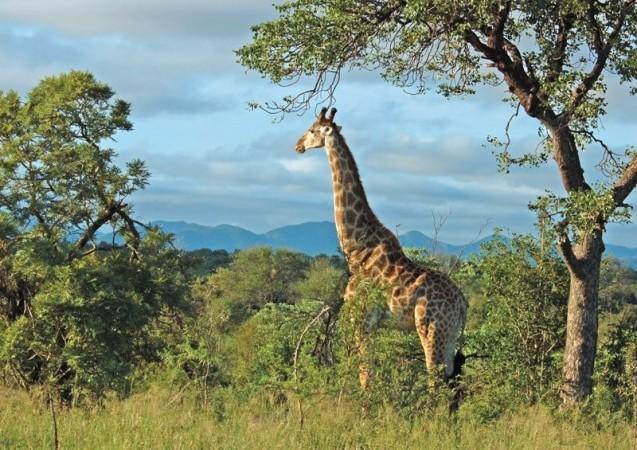
Witness Mbombela's natural beauty at Kruger National Park - © Britannica
Essential Travel Information
Getting Around Mbombela
- Car Rental: Renting a car is an easy way to see Mbombela and its surrounding attractions. Several car rental agencies operate in the city, offering a range of vehicles to suit your needs. Having your own transportation provides flexibility to visit places like Kruger National Park at your own pace.
- Taxis and Ride-Sharing: Taxis are available in Mbombela, but it’s recommended to use reputable companies or ride-sharing apps like Uber for a more reliable and safer option. Ride-sharing services are popular and provide an easy way to get around the city without the hassle of parking.
- Public Transport: Public buses operate within the city and to nearby towns. While not as common as in larger cities, they are a cost-effective way to travel around. Be sure to check the schedules and routes in advance to plan your trips effectively.
ATM & Banking Services
In Mbombela, managing your finances is straightforward with a range of banking services available. ATMs are widely scattered across the city, allowing you to withdraw cash in South African Rand (ZAR) using international cards. Several banks offer comprehensive services, including currency exchange, cash withdrawals, and account management, with branches typically open during standard business hours. Credit and debit cards are accepted at most businesses, but carrying some cash is advisable for smaller transactions or locations that do not accept cards.
Where to Stay in Mbombela
- Luxury Hotels: For those seeking a high-end experience, Mbombela has several luxury lodges and hotels that provide upscale amenities. Expect features such as fine dining, swimming pools, and spa services, offering a comfortable and elegant stay.
- Mid-Range Hotels: If you’re looking for a balance between comfort and affordability, there are numerous mid-range hotels available. These typically offer well-appointed rooms, free Wi-Fi, and convenient locations close to the city’s attractions, making them a practical choice for travelers.
- Guesthouses: For a more personalized experience, consider staying at a guesthouse or bed and breakfast. These options provide a homely atmosphere and often include breakfast, offering a warm and welcoming environment that reflects the local character.
- Budget Lodgings: Travelers on a tight budget will find various affordable accommodations in Mbombela, including hostels and self-catering units. These options offer essential amenities at lower prices, ideal for those looking to save on accommodation costs while still enjoying a comfortable stay.
Articles for you

Explore Yala National Park - Sri Lanka Travel, Asia
Tucked away in Sri Lanka’s southeastern corner, Yala National Park is where wild nature meets deep tradition. Known worldwide for its leopard population, the park is also home to elephants, sloth bears, crocodiles, and hundreds of bird species. Beyond wildlife, Yala opens doors to a cultural landscape dotted with ancient temples, Buddhist ruins, and coastal villages. For travelers seeking more than just a safari, Yala offers a chance to explore eco-tourism, local communities, and sacred heritage sites.
Population: The Yala National Park area doesn’t have a human population.
Economy: The economy around Yala National Park thrives on a blend of eco-tourism, agriculture, and local services. Safari tours, eco-lodges, and cultural experiences drive steady income for nearby towns like Tissamaharama and Kataragama, supporting thousands of families.
Landmarks: Famous for Block I of Yala and wildlife encounters, including elephants, sloth bears, crocodiles, and exotic bird species.

Explore Galle - Sri Lanka Travel, Asia
Nestled on Sri Lanka’s southern coastline, Galle is a vibrant city where history meets the sea. Its cobbled streets, colonial architecture, and serene beaches make it a must-visit destination for travelers seeking a blend of culture, adventure, and relaxation. A UNESCO World Heritage site, Galle captivates visitors with its Dutch Fort, bustling markets, and friendly locals. Whether you’re exploring the ramparts at sunset or savoring fresh seafood by the shore, Galle promises an unforgettable journey into Sri Lanka’s heritage.
Population: Approximately 113,000 in 2023.
Economy: Galle’s economy thrives on tourism, trade, and fisheries. The city’s historic fort, colonial architecture, and coastal charm draw thousands of international visitors each year, making tourism its main economic driver. Fishing remains vital for local livelihoods, supplying fresh seafood across the region.
Landmarks: Famous for the Galle Fort, Dutch Reformed Church & Maritime Museum, and Unawatuna Beach.

Explore Bentota - Sri Lanka Travel, Asia
Nestled along Sri Lanka’s southwestern coast, Bentota is a tropical paradise that blends golden beaches, vibrant culture, and thrilling adventures. Famous for its calm waters, luxury resorts, and scenic river estuary, Bentota has become a top destination for travelers seeking both relaxation and authentic experiences. From serene beach walks at sunrise to adrenaline-pumping water sports, this coastal town offers a perfect balance of leisure and exploration. With its proximity to Colombo and Galle, Bentota is easy to reach, making it an ideal stop for both short escapes and extended holidays.
Population: Approximately 37,000 in 2023.
Economy: Bentota’s economy thrives mainly on tourism, which drives local businesses such as hotels, restaurants, and wellness retreats. The town also benefits from fishing, coconut cultivation, and handicrafts like wood carving and batik textiles. Many residents rely on the growing demand for water sports and Ayurvedic treatments, making tourism the backbone of both income and employment in the area.
Landmarks: Famous for Bentota Beach, Bentota River Safari, and Kande Vihara Temple.

Explore Mirissa - Sri Lanka Travel, Asia
Mirissa is a charming coastal town on Sri Lanka’s southern shoreline. Known for its golden beaches, turquoise waters, and vibrant marine life, it has become a must-visit stop for travelers exploring the island. Many come for whale watching, surfing, and sunset views at Coconut Tree Hill, but Mirissa offers much more than postcard beauty. The fishing boats you see anchored by the bay carry generations of stories. Local traditions, delicious cuisine, and a laid-back rhythm of life shape every visitor’s experience.
Population: Approximately 4,700 in 2023.
Economy: Mirissa’s economy is largely shaped by its coastal location. Fishing has long been the backbone of local livelihoods, with generations relying on the Indian Ocean for income. In recent decades, tourism has become the main driver of growth, thanks to whale watching, surfing, and beachside hospitality.
Landmarks: Famous for Mirissa Beach, Coconut Tree Hill, and Parrot Rock Bridge.

Explore Nuwara Eliya - Sri Lanka Travel, Asia
Tucked away in the Central Highlands of Sri Lanka, Nuwara Eliya is often called “Little England”. With its rolling tea plantations, cool misty mornings, and colonial charm, this mountain town feels like a step into another world. Travelers come here to breathe fresh air, walk through flower gardens, sip the finest Ceylon Tea, and enjoy a pace of life far from the island’s busy cities. Whether you’re drawn by scenic landscapes, heritage architecture, or the warmth of its people, Nuwara Eliya is a destination that blends nature, culture, and history in perfect harmony.
Population: Approximately 781,000 in 2023.
Economy: Nuwara Eliya’s economy thrives mainly on tea production, as it sits in the heart of Sri Lanka’s central highlands, famous worldwide for Ceylon Tea. The city also benefits from a growing tourism industry, attracting visitors with its colonial charm, cool climate, and scenic landscapes.
Landmarks: Famous for Gregory Lake, Hakgala Botanical Garden, and Victoria Park.

Explore Sukau - Malaysia Travel, Asia
Nestled on the banks of the Kinabatangan River in Sabah, Malaysian Borneo, Sukau is a destination where wildlife, culture, and conservation come together. Known as one of Asia’s top spots for river safaris and eco-tourism, this quiet village offers a front-row seat to encounters with Bornean orangutans, pygmy elephants, proboscis monkeys, and exotic birdlife.
Population: Approximately 1,400 in 2019.
Economy: Sukau’s economy is shaped by its riverine location and natural resources. Traditionally, the Orang Sungai community relied on fishing, small-scale farming, and forest gathering for their livelihood. Today, the village has shifted toward eco-tourism, with river cruises, jungle trekking, and homestays providing income.
Landmarks: Famous for the Kinabatangan River cruises, Gomantong Caves, and Ox-bow lakes and wetlands.
